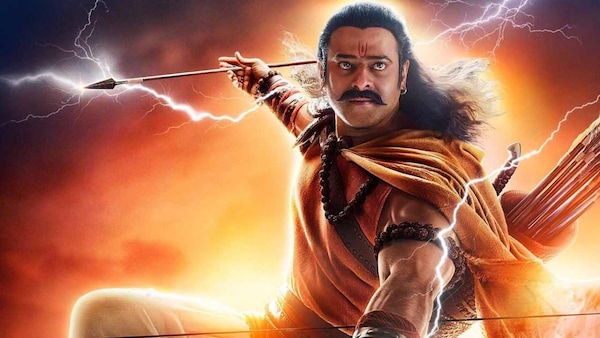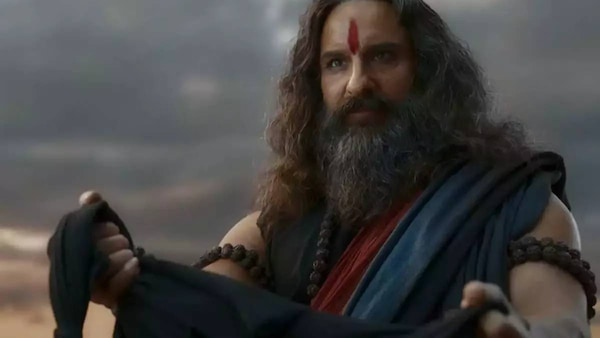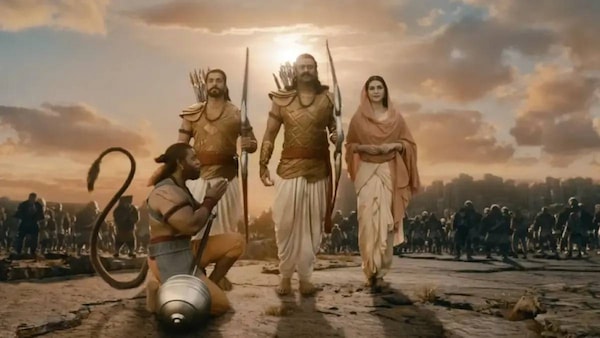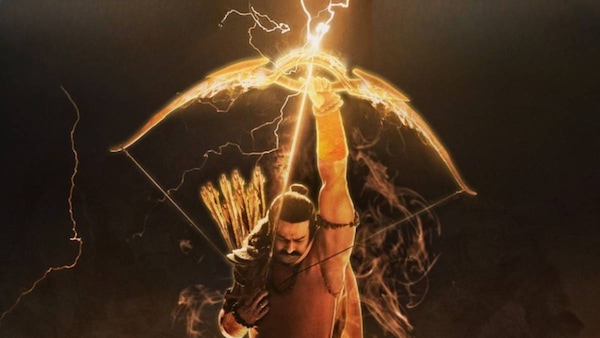Adipurush: A Bloated Take On The Ramayana, With Jarring VFX
This is #CriticalMargin, where Ishita Sengupta gets contemplative over new Hindi films and shows. Today: Adipurush.

Last Updated: 07.08 PM, Jun 16, 2023
ON paper, Om Raut’s Adipurush, a retelling of the Ramayana, has been in the making for three years. But in reality, the film has been in the making for a while, gestating in India’s current political climate. Valmiki’s work, that centers on the righteousness of Lord Rama, has sustained less as an epic and more as a warcry, with the central figure co-opted as an aggressive Hindu deity in a country that is increasingly becoming saffronised. This distortion, in turn, has lent a fatigue to the epic, which is a shame because when viewed in isolation, it is a rapturous work of storytelling with characters so well-rounded that even when the narrative is designed as good versus evil, the reading it encourages is never that simple. On paper (again), the prospect of a film on the Ramayana presented the possibility of underlining its appeal without an agenda. But Raut’s outing not only hinges on the binaries but is also designed around them, milking the impending confrontation of Ram and Ravana to blast “Jai Siya Ram” at least 266 times
The Ramayana, written approximately during 200 B.C.E, comprises seven parts. Adipurush focuses on the time when Rama, his brother Lakshmana, and wife Sita, are living in the Dandaka forest after being exiled from Ayodhya for 14 years. The context to this, Kaikeyi extracting a promise from King Dasharatha, is relayed through quick snapshots. The story from here is familiar: Ravana is granted immortality by Brahma. Shurpanakha, his sister, expresses her desire to marry Rama, upon which Lakshmana cuts her nose. Humiliated, she eggs Ravana on to take revenge in the form of abducting Sita. And so he does.

Raut, who helmed Tanhaji, before this, does not believe in subtlety. In his hands, the retelling becomes an excessively moralistic tale where everything and everyone associated with Rama is good and saffron and everything and everyone associated with Ravana is bad and black. Thus the forest where Rama (a stoic Prabhas) lives is abound with CGI rabbits and peacocks and swathed in green. While Lanka, on the other hand, is depicted as a futuristic superstructure. The place is drenched in black, as is Ravana (Saif Ali Khan). His army comprises men who seem straight out of the sets of Mad Max: Fury Road. They look like Gollum and don Darth Vader masks. His son Indrajit (Vatsal Sheth) is more sinister and cannot be defeated unless in water.
It is needless to reiterate that while Adipurush touches upon the main events of the time, it also takes creative liberties. The film, however, covers its tracks in an unending disclaimer in the beginning that states it should not be “misconstrued as factual or historical representation”. Fair enough. It is also too late in the day to voice such grievances. But even with deviations and a fairly straightforward, familiar story where Ravana’s scholarly bent of mind is distilled in one unforgettable scene in which hordes of pythons are wrapped around his body and one hisses near his nipples, Adipurush fails to evoke any sense of awe. The scale is impressive. The film includes the abduction of Sita (Kriti Sanon), the gathering of the Vanara Sena (the monkey army), the building of the Rama Setu, Hanuman going on the Sanjivani quest and carrying an entire hill, and finally the battle between Rama and Ravana.

Even then, Adipurush lacks ingenuity. This is saying something because the outing (mounted on a staggering budget of Rs 500 crores) stands on visual effects. But like most Hindi films (with the exception perhaps of Amar Kaushik’s Bhediya), the VFX is shaky and even jarring. It hangs so overwhelmingly on the narrative that it robs Adipurush of an(y) emotional core. Rama and Sita are depicted as a strangely insipid couple with their separation evoking no reaction in me. She seems equally unhappy in the forest and under the cherry blossoms in Ashok Vatika (yes, it is cherry blossom season in Lanka).
Their tedious chemistry can also be a product of a filmmaker walking on eggshells while telling a story so integral to Hindu mythology. Of late, the religious intolerance is so dialled up that even when he has made a film like Adipurush which literally translates to Rama being the first man and thus the common forefather of all, Raut has refrained from using their names. Thus, Rama is referred to as Raghava, Sita as Janaki, Ravana as Lankesh, Lakshmana as Shesh, and Hanuman as Bajrang.
The handful of times the film chooses to have fun is when it focuses on Lankesh and Lanka. It is easy to see why: the restrictions are fewer. Raut’s reimagination of the place, akin to the aesthetic of Game of Thrones, is a dystopian universe brimming with a sense of doom. The weapons there are almost avante-garde and the language spoken is strangely modern, differing starkly from Raghav’s vocabulary which includes a lot of “prateeksha” and “dharam”. On the contrary, when Bajrang (Devdatta Nage) goes to Ashok Vatika to meet Janaki and is spotted by someone, the latter questions his presence by asking if the place is his “bua ka bageecha?” (his aunt’s garden). The linguistic difference, an expression of contrasting morality, between the two worlds made me wonder if it was Raut’s way of suggesting that the past, with chaste Hindi and untarnished Hinduism, was the golden age we have left behind. And the future, which includes snakes and non-vegetarian palates, is evil.

The implication, however, has no bearing on Khan. The actor, who has made a habit out of acting in misleading historicals and then apologising for it, hams it up as always. He has the most fun as he goes all unhinged. This is no Tanhaji, where he essayed the role of Mughal general Udaybhan Rathod with aplomb, but Khan still makes a meal out of the character, dominating the screen with his elevated frame (VFX) and then, in a moment’s notice, making faces to a bird. His 10 faces might be wobbly but his performance is not. However, he is an exception.
Much like the staid storytelling in Adipurush, even the portrayals are stilted. Prabhas brings the physicality but his Ragahv (dubbed by Sharad Kelkar) is depicted as a frustratingly vacuous and uninteresting character. Whatever might be the reason (backlash? protests?), there is little about him to be invested in, even as he occupies most of the frame. Also, he is a pretty lousy runner. Sunny Singh’s Punjabi twang is unmistakable and honestly, it is a marvel how little he has to do as Shesh.
Which brings me to the best performers in the film: the animals. There are all kinds. There are monkeys, big monkeys, chimpanzees, and I, for one, was rooting for the second-in-command bear who valiantly fought in the battle against Lankesh and his army. Somewhere in Adipurush there is a story of animal conservation, a reminder how they are who we have come from. I just wish it translated better.

 Premium
Premium